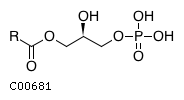
CHEBI:16975
| Name | 1-acyl-sn-glycerol 3-phosphate |  Download: mol | sdf |
| Synonyms | 01-acyl-sn-glycerol 3-phosphate; 2-lysophosphatidate; 2-hydroxy-3-(phosphonooxy)propyl octadec-9-enoate; Lpa; Lysophosphatidate; Lysophosphatidic acid; | |
| Definition | NA | |
| Molecular Weight (Exact mass) | NA | |
| Molecular Formula | C4H8O7PR | |
| SMILES | O[C@H](COC([*])=O)COP(O)(O)=O | |
| InChI | InChI=1S/C6H14O12P2/c7-3(1-17-19(11,12)13)5(9)6(10)4(8)2-18-20(14,15)16/h3,5-7,9-10H,1-2H2,(H2,11,12,13)(H2,14,15,16)/t3-,5-,6-/m1/s1 | |
| InChI Key | XPYBSIWDXQFNMH-UYFOZJQFSA-N | |
| Crosslinking annotations | KEGG:C00681 | ChEBI:16975 | LIPIDMAPS:LMGP10050000 | PubChem:3950 | |
| Pathway ID | Pathway Name | Pathway Description (KEGG) |
| map00561 | Glycerolipid metabolism | NA |
| map00564 | Glycerophospholipid metabolism | NA |
| map01100 | Metabolic pathways | NA |
| map01110 | Biosynthesis of secondary metabolites | NA |
| map04072 | Phospholipase D signaling pathway | Phospholipase D (PLD) is an essential enzyme responsible for the production of the lipid second messenger phosphatidic acid (PA), which is involved in fundamental cellular processes, including membrane trafficking, actin cytoskeleton remodeling, cell proliferation and cell survival. PLD activity can be stimulated by a large number of cell surface receptors and is elaborately regulated by intracellular factors, including protein kinase C isoforms, small GTPases of the ARF, Rho and Ras families and the phosphoinositide, phosphatidylinositol 4,5-bisphosphate (PIP2). The PLD-produced PA activates signaling proteins and acts as a node within the membrane to which signaling proteins translocate. Several signaling proteins, including Raf-1 and mTOR, directly bind PA to mediate translocation or activation, respectively. |
| map04540 | Gap junction | Gap junctions contain intercellular channels that allow direct communication between the cytosolic compartments of adjacent cells. Each gap junction channel is formed by docking of two 'hemichannels', each containing six connexins, contributed by each neighboring cell. These channels permit the direct transfer of small molecules including ions, amino acids, nucleotides, second messengers and other metabolites between adjacent cells. Gap junctional communication is essential for many physiological events, including embryonic development, electrical coupling, metabolic transport, apoptosis, and tissue homeostasis. Communication through Gap Junction is sensitive to a variety of stimuli, including changes in the level of intracellular Ca2+, pH, transjunctional applied voltage and phosphorylation/dephosphorylation processes. This figure represents the possible activation routes of different protein kinases involved in Cx43 and Cx36 phosphorylation. |
| map04810 | Regulation of actin cytoskeleton | NA |
| map04975 | Fat digestion and absorption | Fat is an important energy source from food. More than 95% of dietary fat is long-chain triacylglycerols (TAG), the remaining being phospholipids (4.5%) and sterols. In the small intestine lumen, dietary TAG is hydrolyzed to fatty acids (FA) and monoacylglycerols (MAG) by pancreatic lipase. These products are then emulsified with the help of phospholipids (PL) and bile acids (BA) present in bile to form micelles. Free FAs and MAGs are taken up by the enterocyte where they are rapidly resynthesized in endoplasmic reticulum (ER) to form TAG. PLs from the diet as well as bile - mainly LPA - too are absorbed by the enterocyte and are acylated to form phosphatidic acid (PA), which is also converted into TAG. Absorbed cholesterol (CL) is acylated to cholesterol esters (CE). Within the ER, TAG joins CE and apolipoprotein B (ApoB) to form chylomicrons that enter circulation through the lymph. |
| map04977 | Vitamin digestion and absorption | Vitamins are a diverse and chemically unrelated group of organic substances that share a common feature of being essential for normal health and well-being. They catalyze numerous biochemical reactions. Because humans and other mammals cannot synthesize these compounds (except for some synthesis of niacin), they must obtain them from exogenous sources via intestinal absorption. Vitamins are classified based on their solubility in water or fat. Most of the water-soluble vitamins are transported across the small intestinal membrane by carrier-mediated mechanisms, but vitamin B12, cobalamin, is transported by a receptor-mediated mechanism. Intestinal absorption of fat-soluble vitamins requires all of the processes needed for fat absorption. After digestion, these vitamins and the products of pancreatic hydrolysis of triglycerides (TG) are emulsified by bile salts to form mixed micelles which are taken up by intestinal enterocytes and incorporated into chylomicrons (CM). CM are then secreted into the lymphatic system, and finally moves into the plasma. |
| map05200 | Pathways in cancer | NA |

